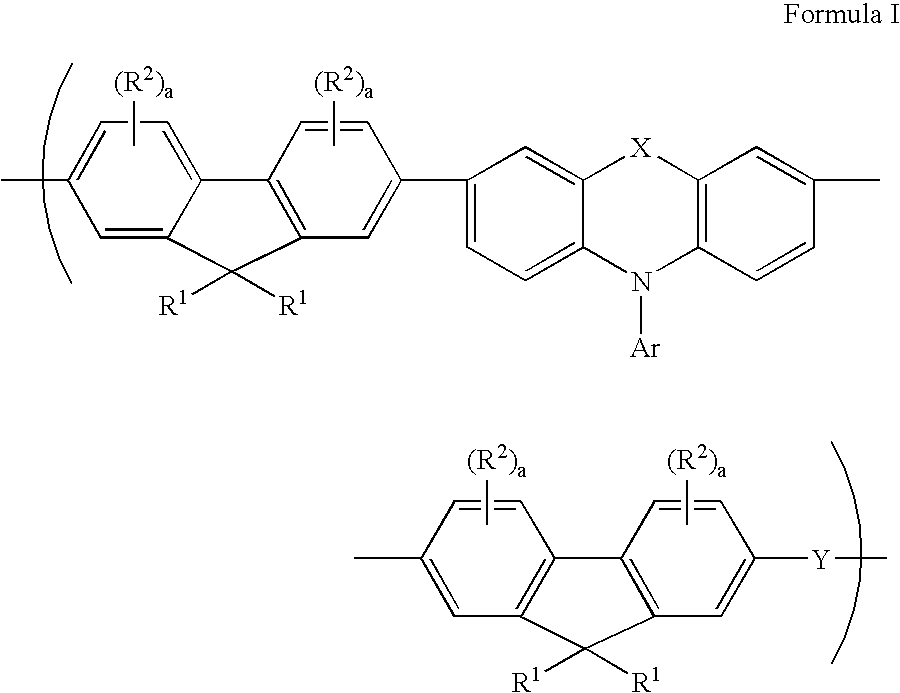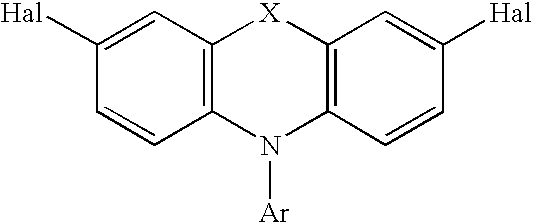Tricyclic arylamine containing polymers and electronic devices therefrom
a technology of tricyclic arylamine and electronic devices, which is applied in the direction of luminescent compositions, transportation and packaging, other domestic articles, etc., can solve the problem that hsieh does not provide data relating to devices containing polymers of fluorene containing repeat units
- Summary
- Abstract
- Description
- Claims
- Application Information
AI Technical Summary
Benefits of technology
Problems solved by technology
Method used
Image
Examples
example 1
[0085] Synthesis of Tricylic Arylamine Units 10
N-(4-n-Butylphenyl)phenothiazine (1: X=S)
[0086] A 2 L 3 neck round bottom flask equipped with overhead stirrer, reflux condensor and a nitrogen line was charged with 0.948 g (4.216 mmol) palladium acetate and 2.647 g (8.746 mmol) tri-o-tolylphosphine and 50 ml toluene. The mixture was stirred at ambient temperature for 20 minutes until an orange-red solution was formed. At that time, phenothiazine (19.93 g, 100 mmol), 1-bromo-4-butyl benzene (23.6 g, 110 mmol) and sodium t-butoxide (10.71 g, 100 mmol) along with 1000 mL toluene was added. The reaction was placed in an oil bath and heated to reflux for 15 hours. A sample was taken for HPLC showing that all starting material was gone. A major peak with the retention time of 8.6 minutes was seen. The soultion was cooled. 15 mL concentrated HCl was added. The solution was stirred for an additional hour. Then the solution was passed through a neutral alumina column (750 g). The column was ri...
example 2
[0090] 11
N-(9,9-Di-n-butylfluorene)phenothiazine (5: X=S)
[0091] A mixture of palladium acetate (180 mg, 0.81 mmol), tri-o-tolylphosphine (530 mg, 1.74 mmol) and toluene (12 mL) was stirred at ambient temperature for 30 minutes until a homogenous yellow solution was formed. The reaction mixture was covered under nitrogen. Phenothiazine (3.99 g, 20 mmol), 2-bromo-9,9-dibutylfluorene (7.85 g, 22 mmol), sodium tert-butoxide (2.88 g, 30 mmol) and more toluene (175 mL) was added to this mixture. The reaction vessel was placed into an oil-bath and heated to reflux overnight. HPLC showed that the reaction was incomplete. An additional 800 mg of 2-bromo-9,9-dibutyfluorene was added to the reaction flask. The mixture was refluxed for an additional 6 hours. The mixture was then cooled to ambient temperature, treated with hydrochloric acid (10 mL), passed through a column of neutral Alumina (Brockman Activity I) and eluted with toluene. The solvent was removed on a rotary evaporator under reduc...
example 3
Polymerization Procedure of Polymer 1-Blue Light Emitting Polymer
[0095] 2,7-Bis(1,3,2-dioxaborolan-2-yl)-9,9-dihexylfluorene (3.554 g, 7.4857 mmol), 2,7-dibromo-9,9-dihexylfluorene (3.074 g, 6.2381 mmol), 3,7-dibromo-N-(4-n-butylphenyl)phenothiazine (0.193 g, 0.3669 mmol), 2,7-dibromo-9,9-dibiphenylfluorene (0.231 g, 0.3669 mmol) and N,N'-bis(4-bromophenyl)-N,N'-bis(4-n-butylphenyl)phenylenediamine (0.253 g, 0.3669 mmol), phase transfer reagent Aliquat 336.RTM. (1.21 g), tetrakis(triphenylphosphine)palladium (10.9 mg), and 50 mL toluene were added to a 250 mL three necked round bottom flask equipped with a stir shaft, glass stopper and reflux condensor. The solid was allowed to dissolve in toluene then 15.5 mL of a 2M Na.sub.2CO.sub.3 solution was added. The total volume of the mixture was 65.5 mL. The entire system was connected to a nitrogen line through the reflux condenser so that a dynamic blanket of nitrogen was over the solution throughout the duration of the reaction. All so...
PUM
| Property | Measurement | Unit |
|---|---|---|
| turn-on voltage | aaaaa | aaaaa |
| voltages | aaaaa | aaaaa |
| voltages | aaaaa | aaaaa |
Abstract
Description
Claims
Application Information
 Login to View More
Login to View More - R&D
- Intellectual Property
- Life Sciences
- Materials
- Tech Scout
- Unparalleled Data Quality
- Higher Quality Content
- 60% Fewer Hallucinations
Browse by: Latest US Patents, China's latest patents, Technical Efficacy Thesaurus, Application Domain, Technology Topic, Popular Technical Reports.
© 2025 PatSnap. All rights reserved.Legal|Privacy policy|Modern Slavery Act Transparency Statement|Sitemap|About US| Contact US: help@patsnap.com



